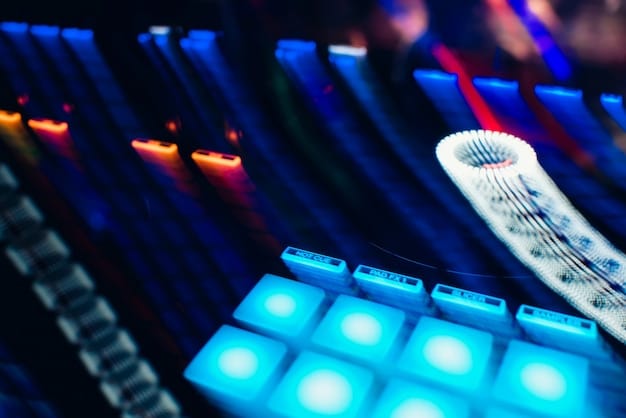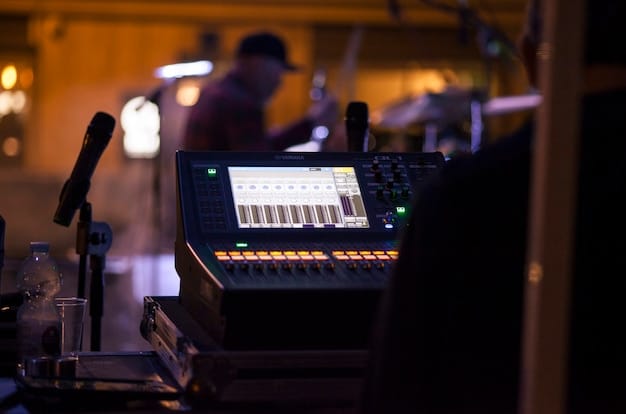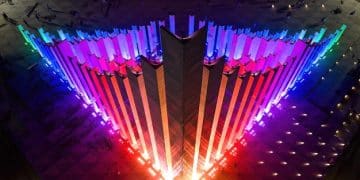Concert Tech Revolution: 5 Innovations for Live Music in 2025

The Concert Tech Revolution in 2025 is set to redefine live music experiences through innovations like immersive soundscapes, personalized experiences, AI-driven performances, interactive visual displays, and sustainable concert solutions.
Get ready to experience live music like never before! The way we enjoy concerts is about to be revolutionized. The Concert Tech Revolution: 5 Innovations Changing the Live Music Experience in 2025 promises a future where technology and music blend seamlessly, creating unforgettable moments for fans and artists alike.
The Immersive Soundscapes of Tomorrow
Imagine feeling the music, not just hearing it. In 2025, immersive soundscapes will transform concerts into truly enveloping experiences. This technology moves beyond traditional stereo sound, creating a 3D audio environment that places listeners directly in the heart of the music.
But how will this be achieved?
Spatial Audio Technologies
Spatial audio technologies use advanced algorithms and sophisticated speaker setups to create a sense of depth and dimension. By precisely controlling the direction and timing of sound waves, engineers can simulate the way sound naturally travels and interacts with the environment.
Haptic Feedback Systems
To further enhance immersion, haptic feedback systems are being integrated into concert venues. These systems use vibrations and tactile sensations to complement the audio experience. Attendees might feel the bass drum in their chest or the strum of a guitar in their hands, creating a multisensory connection to the music.
- Enhanced emotional connection to the music
- Increased engagement and excitement
- Improved overall concert satisfaction

These advances promise to elevate the concert experience from a passive listening activity to an active, fully immersive journey, making every note resonate deeper and connect more profoundly.
Personalized Concert Experiences
One size fits all? Not anymore. The future of concerts is about personalization, tailoring the experience to individual preferences. In 2025, technology will enable attendees to customize various aspects of their concert experience, from audio settings to visual displays.
What are the ways in which this will unfold?
Wearable technology is a key component of personalized concerts. Smart wristbands or AR glasses can track audience members’ preferences and adapt the concert environment accordingly. For example, fans can adjust the volume levels of different instruments, choose camera angles for viewing the performance, or even create custom light shows.
AI-powered recommendation systems can also play a role in personalizing the concert experience. By analyzing data on attendees’ musical tastes, social media activity, and past concert attendance, these systems can suggest specific songs, identify potential meetups with other fans, or offer personalized merchandise recommendations.
- Increased sense of ownership and control
- Deeper connection with the artist and music
- More memorable and fulfilling concert experience
Imagine being able to fine-tune your concert experience to match your exact preferences. The possibilities are endless, and the result is a more personal and engaging concert experience for everyone.
AI-Driven Performances
Artificial intelligence is not just for tech companies anymore; it’s making its way onto the stage. In 2025, AI will play an increasingly prominent role in live music performances, adding new layers of creativity and interactivity.
Let’s look at examples of how AI integration is changing the equation:
AI algorithms can analyze live performances and generate real-time visual effects that synchronize with the music. These effects can range from simple color changes to complex animations and 3D projections, creating a mesmerizing visual spectacle.
AI is also being used to create entirely new musical instruments and performance techniques. For example, AI-powered synthesizers can generate unique soundscapes based on environmental data or audience input. Interactive AI systems can even enable musicians to collaborate with virtual bandmates in real time.
Dynamic Setlists
Gone are the days of static setlists. AI can analyze audience reactions in real-time and adjust the setlist accordingly, ensuring that the energy remains high and the crowd stays engaged.
Personalized Jams
Imagine the band taking requests and improvising on the spot, guided by AI that knows exactly what the audience wants to hear. This level of personalization creates a unique and unforgettable live experience.

The integration of AI into live performances promises to push the boundaries of creativity and innovation. It’s not about replacing human artists, but rather augmenting their abilities and creating new forms of artistic expression.
Interactive Visual Displays
Beyond the music, concerts thrive on visual spectacle. In 2025, interactive visual displays will blur the line between the stage and the audience, creating shared experiences that enhance the sense of community.
What is included in these displays?
Giant LED screens react to the music and crowd’s movements, engulfing the venue in a dynamic, ever-changing canvas. Augmented reality (AR) overlays transform the audience’s view, adding virtual elements to the physical environment.
Audience participation is key to these interactive visual displays. Fans can use their smartphones to control elements of the show, from voting on the next song to choosing visual themes. Social media integration allows concertgoers to share their experiences in real-time, creating a virtual extension of the event.
- Enhanced Sense of Community
- More Shared Experiences
- Unforgettable Memories
These visual displays promise to amplify the concert experience, making every attendee an active participant in the show. It’s about creating a collective moment that extends beyond the confines of the stage.
Sustainable Concert Solutions
As environmental awareness grows, the concert industry is embracing sustainable practices. In 2025, innovative technologies will reduce the environmental footprint of live music events, making them greener and more responsible.
But how will these events become more sustainable?
Energy-Efficient Technologies
Concert venues are adopting energy-efficient lighting, sound systems, and climate control technologies. Renewable energy sources, such as solar panels and wind turbines, are being used to power events, reducing reliance on fossil fuels.
Waste Reduction Programs
Waste reduction programs aim to minimize the amount of trash generated at concerts. Reusable cups, plates, and utensils are replacing single-use plastics. Composting programs are turning food waste into valuable fertilizer.
Sustainable Transportation Solutions
Concert organizers are encouraging attendees to use public transportation, carpooling, and cycling. Shuttle services and bike-sharing programs make it easier for fans to travel to and from events without relying on personal vehicles.
- Reduced environmental impact
- Enhanced brand reputation for artists and venues
- Increased appeal to eco-conscious fans
| Key Feature | Brief Description |
|---|---|
| 🎧 Immersive Sound | 3D audio and haptic feedback enhance the listening experience. |
| 📱 Personalized Concerts | Tailoring the experience to individual preferences. |
| 🤖 AI Performances | Live visual effects and virtual musical collaboration. |
| 🌍 Sustainable Solutions | Energy efficiency and waste reduction in shows. |
FAQ
▼
Immersive soundscapes use advanced audio technology to create a 3D sound environment. They give listeners a surround sound experience that deeply involves them in the music.
▼
Wearable tech such as smart wristbands allows fans to customize aspects of a concert, like changing volume and camera angles. AI also recommends songs and meetups based on the fan’s preferences.
▼
AI can generate real-time visuals, create unique musical instruments, and enable musicians to collaborate with virtual bandmates. Dynamic setlists guided by AI can adapt dynamically based on audience feedback.
▼
Sustainable concert solutions use eco-friendly technologies to reduce the environmental impact of live music events. Waste reduction programs and sustainable transport options are included.
▼
The audience can participate in interactive visuals. Giant LED screen and augmented reality integrate the crowd into the show, making the concert a shared and collective experience.
Conclusion
As we look ahead to 2025, it’s clear that the concert experience will be transformed by technology. From immersive soundscapes and personalized experiences to AI-driven performances, interactive visual displays, and sustainable solutions, these innovations promise to enhance live music in ways we never thought possible. The future of concerts is here, and it’s going to be an incredible ride.





